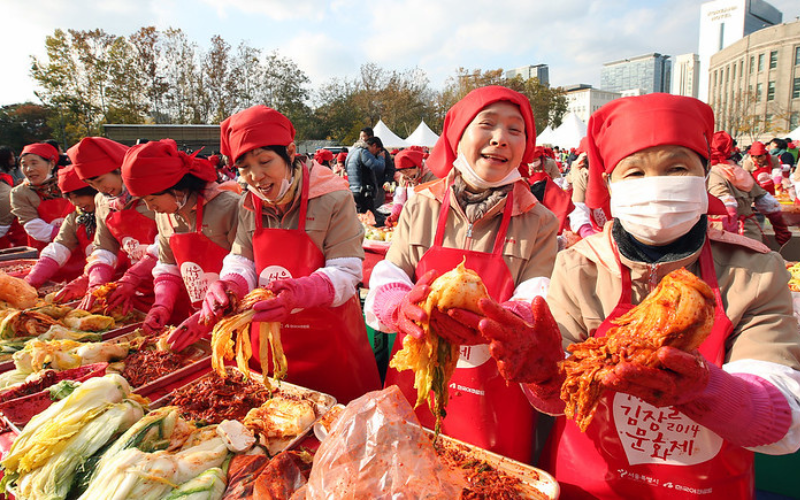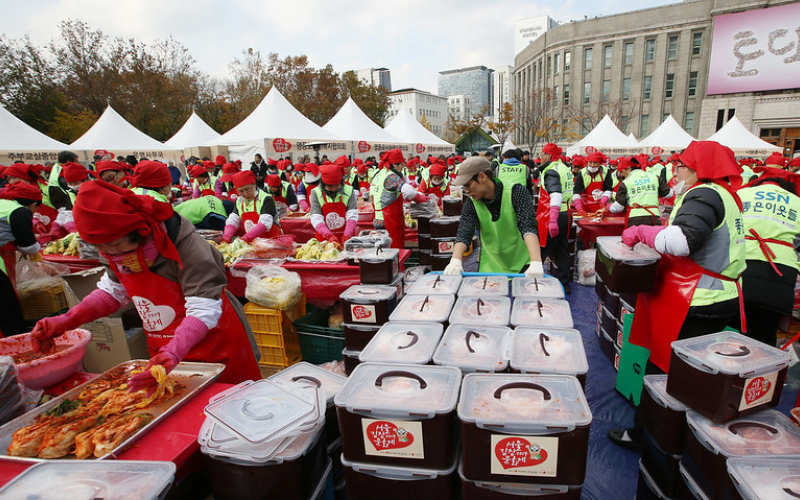Kimchi, Korea's famous fermented side dish, represents far more than just a culinary delight. It embodies the very essence of Korean history, tradition, and community. This November, from November 6th - 8th 2024, the Seoul Kimchi Festival invites visitors to delve deep into the cultural significance of kimchi at Seoul Plaza and Gwanghwamun Square. The festival not only celebrates kimchi but also highlights the tradition of "kimjang", the communal practice of making and sharing kimchi for winter.
At its core, kimchi is a traditional Korean dish made from salted and fermented vegetables, most commonly napa cabbage and Korean radishes, combined with a variety of seasonings like gochugaru (Korean red pepper flakes), garlic, ginger, and jeotgal (salted seafood). However, kimchi goes beyond a simple recipe, it’s a reflection of Korean history, climate, and geography. The practice of fermenting vegetables helped Koreans preserve food through the cold winters when fresh produce was scarce. The result is a dish that’s packed with both flavor and nutrition, known for its high levels of vitamins, probiotics, and antioxidants.
Kimchi has existed for over 1000 years, evolving with the introduction of new ingredients. Before the 17th century, kimchi was not the spicy red dish we know today, as chili peppers were only introduced to Korea in the late 16th century through trade. Today, there are over 200 types of kimchi, each varying by region, ingredients, and fermentation process. In northern regions like Pyongan and Hamgyong, kimchi tends to be less spicy and uses fewer fermented seafoods, while southern regions like Jeolla produce kimchi with bolder flavours and more intense fermentation.

At the heart of the Seoul Kimchi Festival is kimjang, the communal act of preparing kimchi in large quantities, typically at the start of winter. Recognised by UNESCO as an Intangible Cultural Heritage of Humanity, kimjang has been essential to Korean society for centuries. It’s a practice that brings families, friends, and communities together to prepare for the harsh winter months ahead. Traditionally, neighbors would gather to make vast amounts of kimchi, share ingredients, and provide labor, ensuring everyone had enough food to last the winter. This spirit of collaboration and sharing lives on today, not just in rural villages but even in the heart of Seoul.
The Seoul Kimchi Festival aims to keep this tradition alive by encouraging visitors to participate in kimjang. At the event, people will have the chance to make large batches of kimchi under the guidance of seasoned kimchi makers. These batches are then donated to local charities, symbolising the spirit of sharing that kimjang represents.

From my research there are many festival highlights such as:
Kimchi making workshops: join master kimchi-makers in hands-on workshops where participants can learn to make different varieties of kimchi, from classic napa cabbage kimchi to white kimchi (baek kimchi), a milder, non-spicy version.
Culinary demonstrations: watch as chefs demonstrate creative and modern uses of kimchi in various dishes, highlighting its versatility in Korean and global cuisine.
Kimchi market: taste and purchase kimchi from different regions of Korea, each with its unique flavour profile. From Jeolla's bold, spicy kimchi to Gangwon's mild and crunchy versions, visitors will get a sense of Korea’s rich diversity through its kimchi.
Big kimchi share: Visitors are invited to participate in creating large quantities of kimchi that will be distributed to underprivileged communities across Seoul. This charity-driven initiative echoes the traditional spirit of kimjang, where food is shared and no one is left without.
Kimchi is not only delicious but also hailed as a superfood due to its many health benefits. It is rich in probiotics, which aid in digestion and promote gut health, thanks to the fermentation process. While I was living in Korea eating kimchi on a daily bases my gut health has improved significantly and I don't suffer as I used to. Kimchi is also a great source of vitamins A, B, and C, as well as antioxidants, which can help boost immunity. Furthermore, recent studies have suggested that kimchi may help lower cholesterol and improve metabolic health, making it a great addition to a healthy diet. that is why I keep sourcing kimchi whenever I can when I am back in my home country. I once attended a kimchi making class at the Kimchi Museum in Seoul and learned how to make radish kimchi I am yet to learn how to make traditional kimchi.
The festival will be held in Seoul Plaza and Gwanghwamun Square, both iconic locations in the heart of the city. To get there, visitors can take the subway to City Hall Station (Line 1 or 2). The festival is organized by the Seoul Metropolitan Government, and entry is free for all. For those who cannot attend in person, virtual workshops and live streams will also be available, ensuring that people from all over the world can participate in the festival from the comfort of their homes. I will for sure.
The Seoul Kimchi Festival is not just about celebrating food, it’s about honouring the cultural heritage, community spirit, and resilience that kimchi represents. Whether you are making your own kimchi, learning about its rich history, or enjoying the health benefits of this superfood, participating in the Seoul Kimchi Festival offers a unique opportunity to connect with a core part of Korean culture. So, whether you are in Seoul or attending virtually, this is one festival you won’t want to miss.
How about this article?
- Like2
- Support0
- Amazing0
- Sad0
- Curious0
- Insightful2


